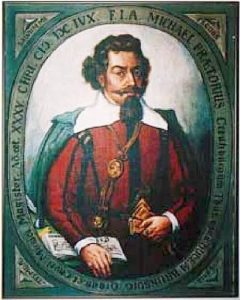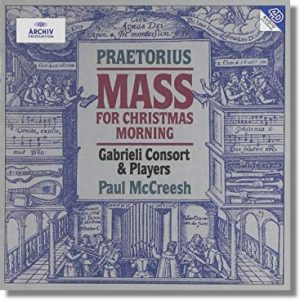
Michael Praetorius (1571-1621) played a profound role in shaping the Lutheran musical tradition as it developed from the late Renaissance into the early Baroque. The son of a devout pastor who had studied with Martin Luther, Praetorius has often been called the “conservator of the chorale,” the Lutheran chorale being the fundamental building block of music in this rich tradition — a musical ecosystem that produced J. S. Bach. In addition to his work as an organist and prolific composer, Praetorius was also a significant music theorist.
This 1994 album of Christmas music reconstructs a Lutheran liturgy as it might have been heard at one of the major churches in central Germany around 1620 (minus the long sermon). The performers on the album — Praetorius Mass for Christmas Morning — are the Gabrieli Consort and Players, conducted by Paul McCreesh. In 1993, the ensemble released a similar album called Christmas Mass in Rome which imagined the music heard in a Roman Catholic liturgy around 1620, all ordered around Palestrina’s Missa Hodie Christus natus est. Since (unlike the Roman mass) the Lutheran liturgy would have included lots of congregational singing, for the Praetorius recording McCreesh augmented his singers with the Boys Choir and Congregational Choir of Roskilde Cathedral in eastern Denmark, where the album was recorded.

The worship practices of the Lutheran wing of the Reformation retained much of the Roman Catholic liturgical structure. As does out own Anglican liturgy, the Lutheran mass reconstructed on this recording begins with a Processional hymn, an Introit, and the singing of the Kyrie. The Processional sung here is a harmonization by Lucas Osiander (1524-1604) of an early hymn by Luther, “Christum wir sollen loben schon,” the eight-verses of which are a German paraphrase of a fifth-century Latin hymn (Luther cribbed a lot of his best material from sources in the Patristic period). J. S. Bach based an entire cantata (BWV 121) around this hymn, which honors the Virgin Mary almost as much as her son; the fourth verse reads:
The chaste house of a tender heart
at once became a temple of God;
she who was still untouched and unknown by any man
was found to be with child by God’s word.
That processional hymn is followed by the Introit, the medieval Latin hymn “Puer natus in Bethlehem” (A Child is born in Bethlehem). This arrangement by Praetorius demonstrates how Praetorius combined the Lutheran musical tradition with spectacular multiple-choir techniques that had been developed by Italian composers. The brisk refrain you hear repeatedly sung by the large choir is (in translation): “Sing, rejoice, triumph, all honor to our Lord, the King.”
In the Kyrie that follows, Praetorius alternates between the traditional Greek text, “Kyrie, eleison” (Lord have mercy) and the same plea in German (Herr erbarme dich), demonstrating Luther’s commitment to maintaining the traditional liturgical languages while augmenting them with the vernacular texts.
This alternation between the liturgical tongue and the common speech is also present in the final hymn presented in this liturgical reconstruction. In the joyous Nativity hymn, “Puer nobis nascitur” (To us is born a child), the choir sings a verse in Latin, then the congregation sings a verse in German, and so on back and forth.
The closing track on the recording is a magnificent rendition of the fourteenth-century carol, In dulci jubilo (In sweet rejoicing), scored by Praetorius for four separate choirs, six trumpets, and drums. Do angels envy? If so, the sound of this exuberant praise might tempt them. It’s a fitting conclusion to this glorious medley of praise. I’ve summarized the highlights, but encourage you to obtain the entire album for repeated listening, especially next year on Christmas morning.
To learn more about Michael Praetorius, see chapter 5 in
Carl Schalk’s Music in Early Lutheranism: Shaping the Tradition (1524-1672)
(St. Louis: Concordia Academic Press, 2001).
Postscript: In 2019, I wrote an article about the remarkable impact on the experience of Christmas effected by the music of Praetorius. That article was published in Touchstone magazine.